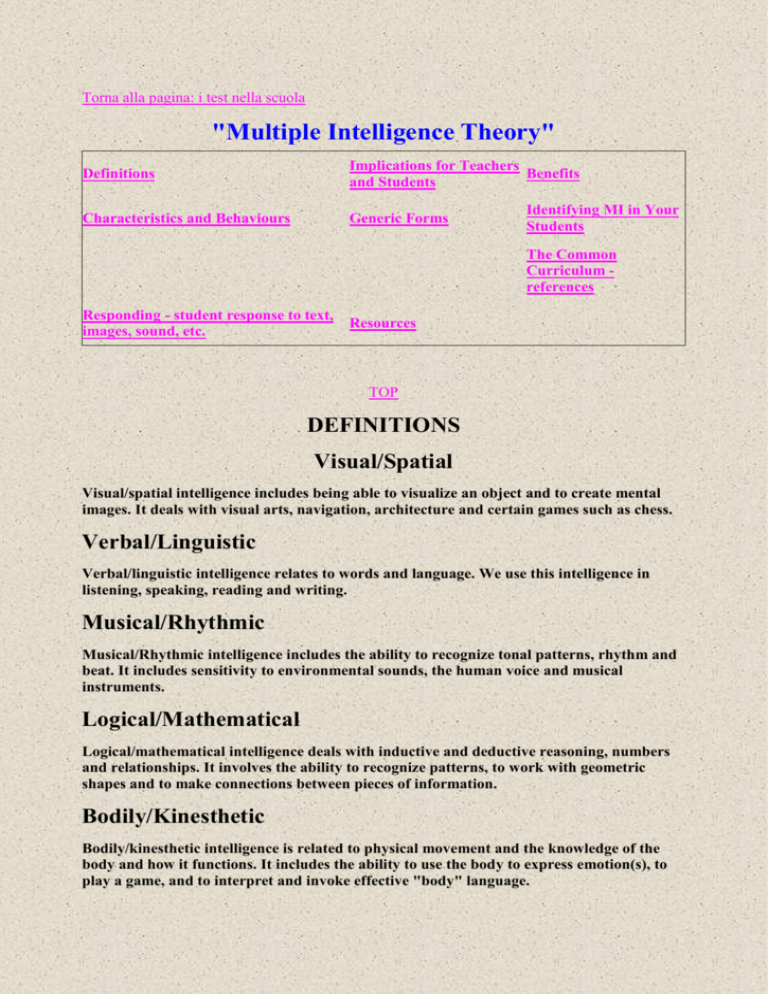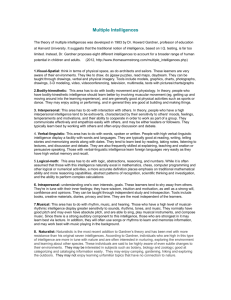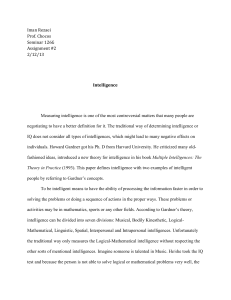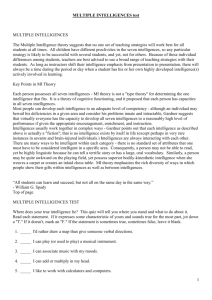SCBE Multiple Intelligence Homepage
advertisement

Torna alla pagina: i test nella scuola "Multiple Intelligence Theory" Definitions Implications for Teachers Benefits and Students Characteristics and Behaviours Generic Forms Identifying MI in Your Students The Common Curriculum references Responding - student response to text, images, sound, etc. Resources TOP DEFINITIONS Visual/Spatial Visual/spatial intelligence includes being able to visualize an object and to create mental images. It deals with visual arts, navigation, architecture and certain games such as chess. Verbal/Linguistic Verbal/linguistic intelligence relates to words and language. We use this intelligence in listening, speaking, reading and writing. Musical/Rhythmic Musical/Rhythmic intelligence includes the ability to recognize tonal patterns, rhythm and beat. It includes sensitivity to environmental sounds, the human voice and musical instruments. Logical/Mathematical Logical/mathematical intelligence deals with inductive and deductive reasoning, numbers and relationships. It involves the ability to recognize patterns, to work with geometric shapes and to make connections between pieces of information. Bodily/Kinesthetic Bodily/kinesthetic intelligence is related to physical movement and the knowledge of the body and how it functions. It includes the ability to use the body to express emotion(s), to play a game, and to interpret and invoke effective "body" language. Interpersonal (torna a: Valutazione e verifica del gruppo cooperativo) Interpersonal intelligence is used in person-to-person relationships. It includes the ability to communicate with others and to have empathy for their feelings and beliefs. Intrapersonal Intrapersonal intelligence is based on knowledge of the "self". It includes metacognition (thinking about thinking), emotional responses, self reflection and an awareness of metaphysical concepts. TOP IMPLICATIONS FOR TEACHERS AND STUDENTS each of us use seven (or more) "intelligences" (learning styles). all intelligences need to be equally valued. all intelligences can be taught, nurtured and strengthened. not all students are well served by schools that focus primarily on the linguistic and logical/mathematical learning styles. everyone learns in different ways at different rates for different reasons. stronger intelligences may be used to awaken and strengthen weaker ones. strength with an intelligence may manifest itself in diverse ways. assessment becomes "How are you smart?" not "How smart are you?" TOP BENEFITS for students: Valuing and nurturing individual differences. Authentic assessment of learning. A challenging, comprehensive and integrated curriculum. Notable improvement in academic achievement, thinking, problem solving, and student retention. Increased self-confidence in ability to learn using many intelligences. Preparation for living, working, and life-long learning in the 21st century. Equal access to learning for all students. Understanding of learning differences instead of learning disabilities. Focus on skill and knowledge necessary to meet Common Curriculum outcomes. Personal and social development as part of the curriculum. for teachers and administrators: A positive climate tht supports, motivates, and promotes success for all students and staff. Improved and expanded repertoire of instructional strategies. varied teaching/instructional approaches that are celebrated and supported. Support in meeting the expectations of The Common Curriculum Increased teacher/parent collaboration Planned and consistent staff development including use of a shared professional vocabulary. Increased involvement in school-wide decisions. Renewed sense of professionalism. TOP CHARACTERISTICS AND BEHAVIOURS Logical/Mathematical Intelligence: NUMBER SMART Thinks conceptually Skilled in reasoning, logic and problem solving Explores patterns, categories and relationships Manipulates the environment to experiment in a controlled way Questions and wonders about natural events Scientists, engineers, computer programmers, accountants Interpersonal Intelligence: PEOPLE SMART Thinks and processes by relating, co-operating and communicating with others Leaders among peers Uncanny ability to sense feelings and intentions of others Understands people, mediates conflict Organizer, communicator, at times manipulative Street smart, has many friends Counselors, business people, politicians, community organizers Bodily Kinesthetic Intelligence: BODY SMART Processes knowledge through bodily sensation Excellent fine-motor co-ordination Gut feelings about things Great at mimicking your best or worst qualities and mannerisms Needs to move around, often labeled hyperactive Athletes, dancers, actors, mimes, clowns Musical/Rhythmic Intelligence: MUSIC SMART Thinks in sounds, rhythms and patterns Sings, hums, whistles to themselves Immediately responds to music Performs and appreciates music and leads in songs Sensitive to environmental sounds: crickets, bells, ambient music Strong opinions of others' music Choirs, orchestra, bands, disc jockeys, theatre Intrapersonal: SELF SMART Skilled in inner focusing Displays a strong personality Deep awareness of inner feelings, dreams and ideas Reflective and analytical Tends to shy away from team activities Recognizes self strengths and weaknesses Requires private space and time Self-employed, researchers, theorists, philosphers Linguistic/Verbal Intelligence: WORD SMART Thinks in words Highly developed auditory skills Plays with sounds in language Great story tellers, tall tales and jokes Loves seeing, saying and hearing words Heads are frequently stuck in a book Likes to write Teachers, journalists, writers, lawyers, translators Spacial/Visual Intelligence: PICTURE SMART Thinks in images and pictures Clear visual images and representations Knows the location of everything Fascination with machines and contraptions Inventors, architects, engineers, mechanics TOP IDENTIFYING MI IN YOUR STUDENTS Talk with other teachers and school personnel Conference with parents Ask students to tell you about their strongest intelligence through: checklists journal autobiography art activity discussion groups projects one-to-one interviews Use questionnaires and checklists Observe behaviours and misbehaviours Document performances Look at school records; grades, test scores, comments, etc. Set up special activities, interest areas designed to give information TOP COMMON CURRICULUM REFERENCES TO MULTIPLE INTELLIGENCES Our students will need to see education as a continuing process in their lives - a way of solving problems creatively and planning effectively for the future. They will need to be able to use many different learning methods, both old and new, and to develop transferable skills. The Common Curriculum emphasizes learning experiences and approaches to learning that develop and foster these skills and habits of mind. Page 7 The Common Curriculum is designed for all students; that is, it recognizes that programs must reflect the abilities, needs, interests, and learning styles of students of both genders and all racial, linguistic, and ethnocultural groups. The expected outcomes described in this document, therefore, allow for the inclusion of diverse content and the use of a wide range of teaching approaches. Page 9 The Common Curriculum promotes integrated learning through programs and activities that help students to see connections and relationships among ideas, among people, and among things in the real world. The ability to see the links among different areas of learning will enable students to use the knowledge and skills developed in one field to learn in another and to relate their learning to real-life situations. Students need the ability to apply existing knowledge in new situations in order to function effectively in an environment of continuous change. Page 10 Curriculum must respond to students' varying strengths and abilities, as well as changing needs and circumstances. In fact, some degree of flexibility must be built into every program, or it will soon become obsolete. Teachers' assessment of student progress will indicate the kinds of adjustments that will be needed to meet the particular needs of individuals or groups as they work towards achieving the common outcomes. A flexible curriculum allows and encourages the use of varied content and a range of teaching and learning methods and resources so that students can develop their personal strengths and pursue their own particular interests. Page 27 Essential Outcome - 10 use the skills of learning to learn more effectively. a. set appropriate goals for their learning, make realistic plans and keep track of and evaluate their progress b. clarify their ideas by reflecting on their own thinking and the responses of others c. describe the connections among various ideas and concepts Students must be able to assess their learning needs, to set themselves appropriate goals, to access and analyze information, to apply what they have learned in various contexts, and to evaluate their progress. They must also become aware of how they learn and be able to explore and assess various learning methods. Page 29 TOP RESPONDING VIA MULTIPLE INTELLIGENCES Gardner's concept of multiple intelligences enables us to offer a variety of response options to students who may use different intelligences. It also incorporates a wide variety of genres and may prepare us for our multimedia future. It also offers the widest possible range of verb, sensation and metaphoric possibilities. Text to Image (Visual Intelligence) Literacy Posters: Make up a lost poster, a wanted poster, a movie poster. Literary Webbing: Make sociograms, word webs or picture webs in response to a book. Plot Profiling: Graphing the ups and downs in the student's feelings about a plot or about the ups and downs of a character. Great for showing that response is on a continuum. Landscaping: Making dioramas of a scene or making a map of the land in a story and showing where the characters went. Advertisements: Respond to pictures/paintings with words and labels. Make up new stories for familiar picture books. Image to Text: Respond to pictures/paintings with words and labels. Make up new stories for familiar picture books. Text to Drama (Bodily-Kinaesethetic Intelligence) New Cast: Create a news report of a story. Report it as if it were true. Have students take roles in the newscast. Text to Math and Logic Pivot Words: These are the words that connect words, sentences and paragraphs together. They represent nothing in the real world and yet without them we cannot think and writers could not write. Words such as "and", "but", "or", "because", "if/then" are essential to comprehension and responding. They are the basis of logical thinking; if verbs, feelings and metaphors are the languages of the body, then these words are the language of the brain. Find these words in text. Feature them as a word of the month. Write pattern books with them, even if you are in grade six (especially if you are in grade six...) Flow Charts and Choose Your Own Adventure Stories: Write and choose your own adventure book. These books are a modern phenomena that take their pattern from computer programming. Each page involves a choice (either/or) and cues a sequence (and then) and outlines a consequence (if/then); you can illustrate these stories on a flow chart. You have written a simple computer program and written the way computer game programmers write. Math to Text: Math journals can be a simple way of getting writing from math, however, so can writing up a recipe. Text to Language (Linguistic Intelligence) Language itself has many forms. Going from one form of language to another can develop and enrich this intelligence. Text to Talk: This may be the most important type of response since it is the most natural. After all, you talk verbally, recommend books with your friends and new reading circles are being formed all the time in Canada. There is one exceptionally clever format for teaching book talk - Aidan Chamber's likes/dislikes/puzzles and patterns format (a puzzle is a question one has about the story). It was based on his work to understand what the essential components of book talk are. Essentially one makes a chart that has four columns: likes, dislikes, puzzles, patterns. One invites the students to respond individually to what they see going on in each category. Facilitated by a teacher, connections are then made about what one likes with a pattern or puzzle. Feeling Graphs: Graphing the ups and downs of a feeling as it transpires over the events of a story starts to illustrate the concept of events causing changes in characters. Response in General: The patterns of response in the likes, dislikes, puzzles and patterns and the retell, relate, reflect taxonomy obviously articulate personal feelings about a text. However, any response is an expression of feeling and so deepens the response and intrapersonal knowledge. Text and Interpersonal Intelligence Drama, Drama, Drama: Almost any type of drama teaches and choreographs the body language and, by taking on a role, one takes on some understanding of a character. Empathy is a quality many want to develop. Costume, no matter how simple, enables students to take on roles. I have had success by playing with a simple folktale like The Three Billy Goats Gruff and introducing variations and new characters. With new characters in old stories, students can see how relations can change and try out new responses. Literary Sociograms: A sociogram is a web that visually illustrates the relations between a group of people. One can take a story and make a sociogram from it. As well, one can visually illustrate a ladder where one looks at the move and countermove of a pair of characters. One can start to attribute cause and effect; this character did this because that character did that. This character feels this way because of the action of that character. Social knowledge can be deepened and this can be a complement to social skills programs or for outlining the real cause of a fight. Interpersonal to Text: Make lists of ways people can get along with one another or get a pen pal program going. TOP RESOURCES Internet Resources THE COMPLETE MIT REFERENCE Books Responding Through Multiple Intelligences Many of the ideas were taken or adapted from the following books which I highly recommend: Johnson, T. and Louis, D. Literacy Through Literature. Toronto. Scholastic Press, 1987. Johnson, T. and Louis, D. Bringing It All Together: A Program for Literacy. Toronto. Scholastic, 1990. Anthony, R., Johnson, T., Mickelson, N., Preece, A. Evaluating Literacy: A Perspective for Change. concord, Ontario. Irwin Publishing, 1991. Also: Armstrong, Thomas. Multiple Intelligences in the Classroom. Alexandria, Va. Association for Supervision and Curriculum Development, 1994. Brown, H. and Cambourne, B. Read and Retell: A Strategy for the Whole Language/Natural learning Classroom. South Melbourne, Autralia. Thomas Nelson, Australia. 1987. Campbell, Linda, Campbell, Bruce, Dickinson, Dee. Teaching and Learning Through Multiple Intelligences. Stanwood, Washington. New Horizons for Learning, 1992. Chambers, Aidan. Tell Me: An Approach to Children's Literature. London, England. Thimble Press, 1993. Farrell, C. Stroytelling: A Guide for Teachers. Toronto. Scholastic Books, 1991. Gallas, Karen. The Languages of Learning: How Children Talk, Write, Dance, Draw and sing Their Understanding of the World. New York and London. Columbia University, The Teachers College Press, 1994. Gardner, H. Frames of Mind: A Theory of Multiple Intelligences. New York. Basic Books, 1983. Gardner, H. Reflections on Multiple Intelligences: Myths and Messages. November 1995, Phi Delta Kappan, 1995. Howard Gardner. Haggerty, Brian. Nurturing Intelligences: A Guide to Multiple Intelligence Theory and Teaching. Toronto, Addison Wesley, 1995. Krechersky, Mara. Project Spectrum: Preschool Assessment Handbook. Cambridge, Massachusetts. Harvard College, 1994. Lazear, David. Seven Ways of Teaching: The Artistry of Teaching with Multiple Intelligences. Palatine, Illinois. Skylight Publishing, 1991. The Mathematical Association(U.K.). Math Talk. Portsmouth, New Hampshire. Heinemann Educational Books, Inc., 1987. McCallum, Richard and Whitiow, Robert. Linking Mathematics and Language: Practial Classroom Activities. Markham, Ontario. Pippin Publishing Limited, 1994. Newkirk, Thomas. More Than Stories: The Range of Children's Writing. Portsmout, N.H. Heinemann Educational Books, 1989. Paley, Vivian Gussin. Bad Guys don't Have Birthdays: Fantasy Play at Four. Chicago, Ill. University of Chicago Press, 1988. Paley, Vician Gussin. The Boy Who Would be a Helicopter: The Uses of Storytelling in the Classroom. Cambridge, Mass., Harvard University Press, 1990. Schwartz, S. and Bone, M. Retelling, Relating and Reflecting: Beyond the Three R's. Concord, Ontario. Irwin Press, 1994. Sullivan, Molly. Feeling Strong, Feeling Free: Movement Exploration for Young children. Washington D.C. National Association for the Education of Young Children, 1982. Wilkinson, Joyce A. The symbolic Dramatic Play - Literacy connection: Whole Brain, Whole Body, Whole Learning. Massachusetts. Ginn Press, 1993. Yardley, Alice. Senses and Sensitivity. Toronto. rubicon Publishing, 1988. Yardley, Alice. Young Children Thinking. Toronto. rubicon Publishign, 1988. Some children's books to help you... Hayes, Sarah and Goffe, Tohl. Stamp Your Feet: Action Rhymes. London. Walker Books Ltd., 1988. Heller, Ruth. Many Luscious Lollipops: A Book About Adjectives. New York. Grosset and Dunlap, 1989. Hidebrandt, Greg. Greg Hidebrandt's Book of Three-Dimensional Dragons. Canada. Little, Brown & Company (Canada) Limited, 1994. Martin, Bill Jr. and Archabault, John. Chicka chicka Boom Boom. New York. Simon & Shuster Inc., 1989. Messenger, Norman. Maing Faces. Toronto. Random House, 1992. Rosn, Michael and Owenburg, Helen. We're Going on a Bear Hunt. London. Walker Books Ltd., 1989. Van Allsburg, Chris. The Mysteries of Harris Burdick. Boston, Houghton Mifflin Company, 1984. TOP © The Simcoe County Board of Education, 1996




